|

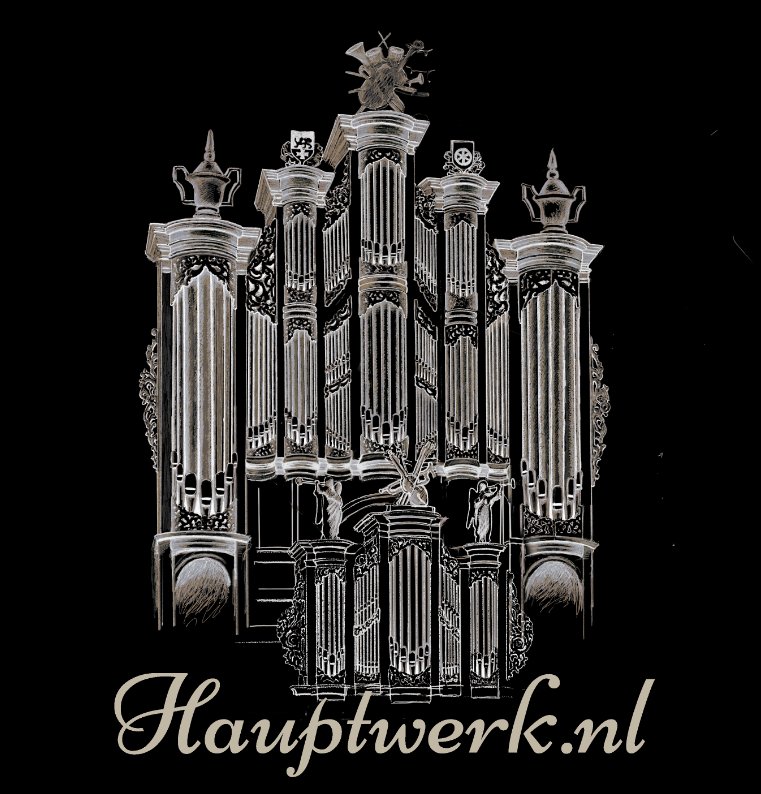








|
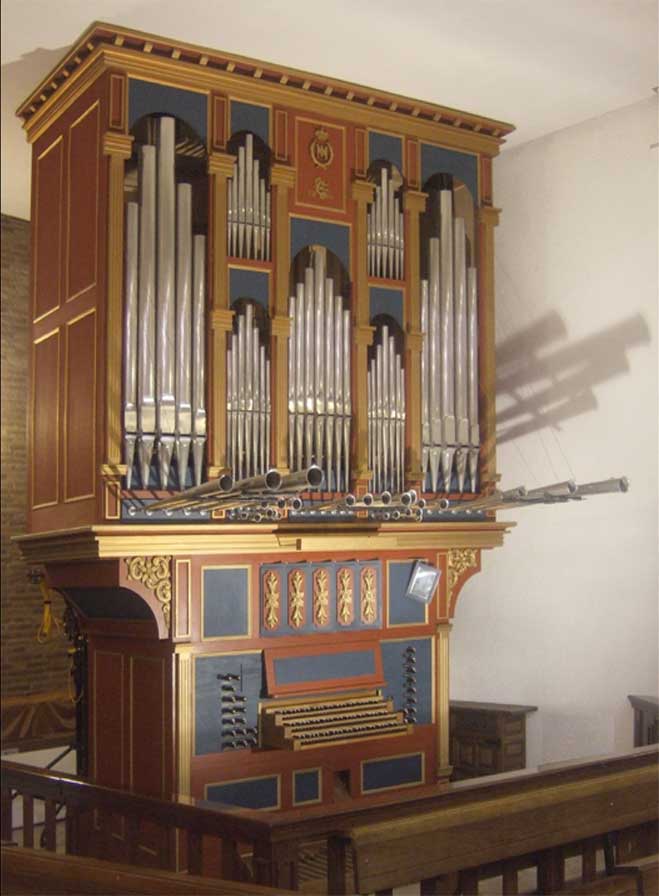
The organfront
|
|
Historical information:
Built in 2004 by Eppo Rynke Ottes (1941-5-8 - 2021-4-20)
Technical information:
Wind pressure OrganoMayor/Pedaal: 78 mm
Wind pressure Organo Expresivo: 67 mm
Tuning: a' = approx. 440 Hz.
Temperament: Unequal temperament "Ottes" (Included with this sample set: Temperament "Mostoles")
Tremulant:
the tremulant affects the Organo Expresivo.
The tremulant was recorded as an integral part of each voice. The beat is arrived at by playing a normal sample modulated by the
waveform derived from the tremulant samples.
Zweltrede:
Swell pedal: the organ has a swell pedal that affects the Organo Expresivo.
The specification is: (+ indicates a Hauptwerk addition.)
|
Manual I: Coplado
(Coupling manual) C-f''' (g''' Hauptwerk)
|
Manual II: Organo Mayor
(Great Organ) C-f''' (g''' Hauptwerk)
|
Manual III: Organo Expresivo
(Swell) C-f''' (g''' Hauptwerk)
|
Pedals: C-f'
|
No voices
Playing aids:
Coupler: Organo Mayor to Pedal - Organo Mayor
Coupler: Organo Expresivo to Pedal
Coupler: OEX to Pedal +
(when used with 2 manual console)
Tremulant Organo Expresivo
Swell pedal Organo Expresivo
|
|
Flautado
Flauta
Octava
Flauta Conica
Quinta
Quincena
Lleno
Trompeta
Trompeta
|
8'
8'
4'
4'
2 2/3 +
2'
II - III strong
8' bass
8' treble
|
|
Violon
Gamba
Voz Humana
Voz Celeste
Flauta chimenea
Nasardo
Corno
Decisetena
Decinovena
Cimbala
|
8'
8'
8'
8' +
4'
2 2/3'
2'
1 3/5'
1 1/3'
I strong
|
|
Subbas
Bajo
Flautado
Octaaf
Quintatón
Fagot
|
16'
8' (Derived from Subbas)
8' (Derived from OM)
4' +
4'
16'
|
|
Construction and composition of the stops
Organo Mayor (Great):
Flautado 8' (Prestant) C - F stopped, Fis - f3 in het front.
Flauta 8' (Spitsfluit) C - e oak, f - f3 metal open 55% lood, hammered.
Octava 4' (Oktaaf)scale slightly smaller then Prestant.
Flauta conica 4' (Koppelfluit) cylindrical with open conical caps (no tuning shade ) 55% lead, hammered.
Quinta 2 2/3' not present in the actual organ, for hauptwerk composed of Quincena 2' and Octava 4'.
Quincena 2' (Superoktaaf) prestant scale, slightly smaller than Oktaaf 4'.
Lleno II-III (Mixtuur, breaks at: C 1 1/3 + 1; e 2 + 1 1/3; gis1 2 2/3 + 2 + 1 1/3; c3 4 + 2 2/3 + 2.
Trompeta 8' horizontally placed trumpet Fis - g2, C - F inside organ case, gis2 - f3 implemented as tapered flue pipes (2 ranks)
The shallots of the reed pipes are made of cherry wood.
Organo Expresivo (Brustwerk):
This division of the organ has five small doors wich can be operated by the swell pedal.
Violon 8' (Stopped) C - e eiken, f - f3 75% lead hammered.
Gamba 8' (narrow Salicinaal) C - e combined with Violon 8' f - h as Quintadeen, c1 - f3 normal length 55% lead hammered.
Flauta chimenea 4' (Roerfluit) C - g2 with relatively long chimneys, gis2 - f3 conical open pipes 75% lead hammered.
Nasardo 2 2/3' (Nasard) C - h stopped, c1 - f3 open.
Flauta conica 4' (Gemshoorn) lightly tapered pipes, in the bass somewhat string-like and in the treble principal-like in character.
Decisetena 1 3/5' (Terts) lightly tapered pipes (Sesquialter-scale).
Decinovena 1 1/3' (Quint) lightly tapered pipes (Sesquialter-scale).
Cimbala I (Cymbel) with nine breaks on every c and fis: C-1/8'; Fis-1/6'; c-1/4'; fis-1/3'; c1-1/2'; fis1-2/3'; c2-1'; fis2-1 1/3'; c3-2'.
when the cimbala is used with additional stops, it sounds like a small mixture!
Voz Humana 8' (Vox Humana) Cylindrical construction with lid.
Voz Celeste 8' not present in the actual organ, for hauptwerk made from flautado 8' of the organo mayor.
Pedal:
Subbajo 16' (Subbas) C - f1 Pine, C - F Horizontally in upper part of organ case.
Flautado 8' derived from Flautado 8' of the Organo Mayor.
Bajo 8' (Bourdon) derived from Subbas 16', f - f1 stopped 75% lead.
Octava 4' not present in the actual organ, for hauptwerk coupled with Octava 4' of the Organo Mayor.
Quintaton 4' (Quintadeen) principal scale, this voice is very suitable as a cantus-firmus stop.
Fagot 16' (Fagot) resonators and boots of solid oak. C - B 1/4 length, c1 - f1 1/2 length.
|
|
The pallet system used in this organ
|
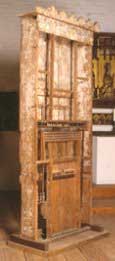
Het orgel in Norrlanda
|
When the space under the pallet leather fills with wind, teh pallet makes an absolutely tight seal against the channel (see the figure
on the right). This has great advantages with respect to the attack and decay of the pipe's speech.
This principal was already being applied during organ building in the gothic period of the 14th century. On the left you can see an image
the organ in Norrlanda Sweden
where this type of pallet construction was already being used.
|
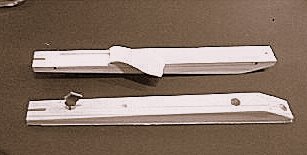
Pallet as found in the organ in Norrlanda
The upper part of the photograph shows
the topside of the pallet with a groove
over which the valve leather has been glued.
The lower part shows a small hole drilled
through the underside.
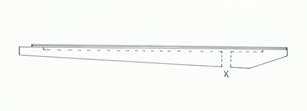
X marks a small opening drilled through the pallet
via wich the organ wind can get underneath the leather.
|
|
|
Hauptwerk.nl is an initiative from Sygsoft Holland. KvK 93602855. Last updated
2024-04-20
|
|
|
